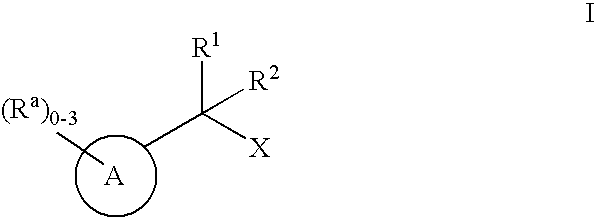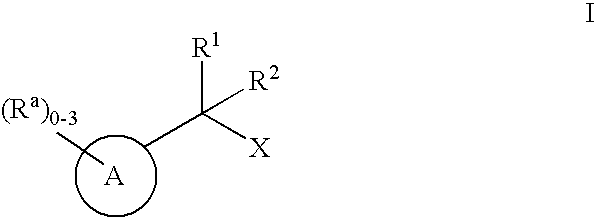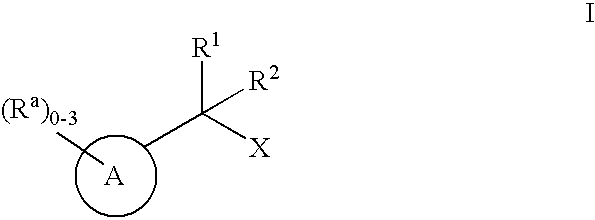Geminally di-substituted NSAID derivatives as Abeta42 lowering agents
a technology of nsaid derivatives and abeta42, which is applied in the direction of biocide, heterocyclic compound active ingredients, drug compositions, etc., can solve problems such as progressive regression of memory and learned functions
- Summary
- Abstract
- Description
- Claims
- Application Information
AI Technical Summary
Benefits of technology
Problems solved by technology
Method used
Image
Examples
example 1
2-(2-Fluoro-1,1′-biphenyl-4-yl)-2-methylpropanoic acid
[0070]
[0071]To 2-fluoro-α-methyl-4-biphenylacetic acid (5.00 g, 20.5 mmol) in methanol (120 mL) was added conc. H2SO4 (0.1 mL) and the resulting solution heated to reflux for 12 hr. After cooling, solid NaHCO3 (˜5 g) was added, the suspension stirred for 10 minutes and filtered. Evaporation of the filtrate to dryness, extraction of the residue with ethyl acetate (˜100 mL), filtration and evaporation to dryness afforded the methyl ester as a colorless oil. 1H NMR (500 MHz, CDCl3) δ 7.46 (2H, m), 7.26-7.38 (4H, m), 7.04-7.09 (2H, m), 3.68 (1H, q, J=7.2 Hz), 3.63 (3H, s), 1.46 (3H, d, J=7.2 Hz).
[0072]To a −78° C. cooled solution of the methyl ester (methyl 2-(2-fluoro-1,1′-biphenyl-4-yl)propanoate) (1.00 g, 3.87 mmol) in THF (7 mL) was added lithium diisopropylamide (0.64M soln in THF; 7.8 mL, 1.3 eq.) dropwise and the resulting orange / red solution stirred at −78° C. for 30 mm. Subsequent warming to 0° C. with an ice bath was follow...
example 2
2-Methyl-2-(3-phenoxy-phenyl)-propionic acid
[0074]
[0075]To a suspension of calcium 2-(3-phenoxy-phenyl)-propionate hydrate (5.00 g, 9.57 mmol) in methanol (150 mL) was added conc. H2SO4 (1.1 mL) and the gelatinous solution heated to reflux for 4 hrs. After cooling, the solution was filtered and evaporated to dryness, the residue dissolved in EtOAc, washed with satd. aq. NaHCO3 soln., dried (MgSO4) and evaporated to yield methyl-2-(3-phenoxy-phenyl)-propionate as a colorless oil. 1H NMR (500 MHz, CDCl3) δ 7.34 (2H, m), 7.26 (1H, m), 7.11 (1H, m), 6.99-7.02 (4H, m), 6.87 (1H, m), 3.70 (1H, q, J=7.2 Hz), 3.67 (3H, s), 1.58 (3H, d, J=7.2 Hz)
[0076]To a solution of methyl-2-(3-phenoxy-phenyl)-propionate (1.00 g; 3.90 mmol) in THF (7 mL) cooled to −78° C. was added lithium diisopropylamide (0.64M soln in THF; 7.8 mL, 1.3 eq.) dropwise and the resulting solution stirred at −78° C. for 30 min. Subsequent warming to 0° C. with an ice bath was followed by the addition of dry hexamethylphosphor...
example 3
2-(4-Isobutyl-phenyl)-2-methyl-propionic acid
[0078]
[0079]To a solution of 2-(4-isobutyl-phenyl)-propionic acid (5.00 g, 24.2 mmol) in anhydrous MeOH (150 mL) was added conc H2SO4 (catalytic) and heated to reflux for 5 hrs. After cooling, the solution was evaporated to dryness, the residue dissolved in methylene chloride, dried (MgSO4), filtered and evaporated to yield methyl 2-(4isobutyl-phenyl)-propionate as a colorless oil. 1H NMR (500 MHz, CDCl3) δ 7.19 (2H, d, J=8,1 Hz), 7.09 (2H, d, J=8.1 Hz), 3.71 (1H, q, J=7.2 Hz), 3.66 (3H, s), 2.44 (2H, d, J=7.2 Hz), 1.84 (1H, app. septet, J=6.7 Hz), 1.48 (3H, d, J=7.2 Hz), 0.90 (6H, d, J=6.6 Hz).
[0080]To a solution of methyl 2-(4-isobutyl-phenyl)-propionate (1.00 g; 4.54 mmol) in THF (8 mL) cooled to −78° C. was added lithium diisopropylamide (0.64M soln in THF; 9.25, 1.3 eq.) dropwise and the resulting solution stirred at −78° C. for 30 min. Subsequent warming to 0° C. with an ice bath was followed by the addition of dry hexamethylphospho...
PUM
| Property | Measurement | Unit |
|---|---|---|
| body weight | aaaaa | aaaaa |
| pH | aaaaa | aaaaa |
| temperature | aaaaa | aaaaa |
Abstract
Description
Claims
Application Information
 Login to View More
Login to View More - R&D
- Intellectual Property
- Life Sciences
- Materials
- Tech Scout
- Unparalleled Data Quality
- Higher Quality Content
- 60% Fewer Hallucinations
Browse by: Latest US Patents, China's latest patents, Technical Efficacy Thesaurus, Application Domain, Technology Topic, Popular Technical Reports.
© 2025 PatSnap. All rights reserved.Legal|Privacy policy|Modern Slavery Act Transparency Statement|Sitemap|About US| Contact US: help@patsnap.com



